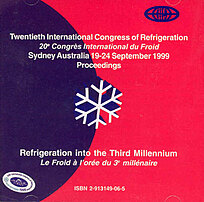
Document IIF
Prévision de la conductibilité thermique des frigorigènes basée sur les états correspondants.
Pure refrigerants thermal conductivity prediction in a corresponding states format.
Auteurs : CRISTOFOLI G., SCALABRIN G., BOBBO S.
Résumé
A three parameters Corresponding States model is here developed importing methods formerly studied for the volumetric representation of fluids. Two fluids of the same conformal family are chosen both for their acentric factor value and for the thermal conductivity dedicated equations avail ability. On the basis of the Teja et al. three parameters CS model for volumetric properties, the reduced thermal conductivity of a third fluid of the family is obtained in reduced P,T utilising, in a first extent, the Pitzer acentric factor as third parameter. The acentric factor is verified to be not suitable as scaling factor for generalised thermal conductivity, also because of in consistency of its argument with transport properties. Two new scaling factors are then assumed to replace Pitzer acentric factor, one for the liquid phase and the other for the vapour phase. These are the only model inputs, allowing t he model to predictively calculate thermal conductivity over the whole domain. The model is here applied to hydrocarbons and HFC refrigerants, included fluoropropanes. Considering the predictive nature of the model and the scattering of the experiment al data sets, the obtained mean accuracy is very good and particularly satisfactory for technical application
Documents disponibles
Format PDF
Disponible
Prix public
20 €
Prix membre*
Gratuit
* meilleur tarif applicable selon le type d'adhésion (voir le détail des avantages des adhésions individuelles et collectives)
Détails
- Titre original : Pure refrigerants thermal conductivity prediction in a corresponding states format.
- Identifiant de la fiche : 2001-1234
- Langues : Anglais
- Source : 20th International Congress of Refrigeration: Refrigeration into the Third Millennium.
- Date d'édition : 19/09/1999
Liens
Voir d'autres communications du même compte rendu (447)
Voir le compte rendu de la conférence
Indexation
- Thèmes : Frigorigènes, frigoporteurs : généralités
- Mots-clés : Thermodynamique; Conductivité thermique; Modélisation; Frigorigène
-
A particles aggregation model for predicting th...
- Auteurs : JIANG W., DING G. L., GAO Y. F., et al.
- Date : 21/08/2007
- Langues : Anglais
- Source : ICR 2007. Refrigeration Creates the Future. Proceedings of the 22nd IIR International Congress of Refrigeration.
- Formats : PDF
Voir la fiche
-
Thermophysical property model of lubricant oils...
- Auteurs : YANG X., RICHTER M.
- Date : 18/07/2024
- Langues : Anglais
- Source : 2024 Purdue Conferences. 27th International Compressor Engineering Conference at Purdue.
- Formats : PDF
Voir la fiche
-
Thermal conductivity of refrigerant fluids: a n...
- Auteurs : LATINI G.
- Date : 23/06/2009
- Langues : Anglais
- Source : 3rd Conference on Thermophysical Properties and Transfer Processes of Refrigerants
- Formats : PDF
Voir la fiche
-
THE MIDAS DATA BASE SYSTEM FOR THE TRANSPORT PR...
- Auteurs : STEPHAN K., HECKENBERGER T.
- Date : 24/08/1987
- Langues : Anglais
- Source : Development in refrigeration, refrigeration for development. Proceedings of the XVIIth international Congress of Refrigeration.
- Formats : PDF
Voir la fiche
-
Determination of refrigerant type using vapour ...
- Auteurs : SNYDER S., MANZ K. W.
- Date : 1993
- Langues : Anglais
- Source : ASHRAE Transactions.
Voir la fiche
